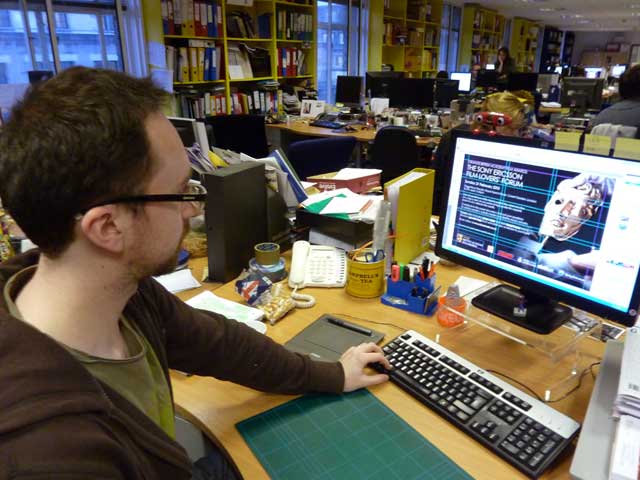Graphic Design: Demand is high for creative skills

Your support helps us to tell the story
From reproductive rights to climate change to Big Tech, The Independent is on the ground when the story is developing. Whether it's investigating the financials of Elon Musk's pro-Trump PAC or producing our latest documentary, 'The A Word', which shines a light on the American women fighting for reproductive rights, we know how important it is to parse out the facts from the messaging.
At such a critical moment in US history, we need reporters on the ground. Your donation allows us to keep sending journalists to speak to both sides of the story.
The Independent is trusted by Americans across the entire political spectrum. And unlike many other quality news outlets, we choose not to lock Americans out of our reporting and analysis with paywalls. We believe quality journalism should be available to everyone, paid for by those who can afford it.
Your support makes all the difference.When you think of the Baftas, images of red-carpet glamour, frilly frocks and Colin Firth no doubt immediately spring to mind. You probably don't envisage a graphic designer sitting in an office, day in, day out, glued to his computer screen as he works on refining the already renowned corporate image of Britain's premier showbusiness awards.
That task belongs to Adam Tuck who has been the in-house designer at British Academy of Film and Television Arts since December last year. His role is crucial to the Baftas because he is responsible for all the visual promotional material about the awards. He designs logos, advertisements and internet campaigns, which is a big job for just one person. Most organisations of any size have such a person beavering away behind the scenes.
Graphic design, he explains, is just one element of design. Its aim is to convey a message to an audience as effectively as possible, usually through visual means. This can include everything from printed or on-screen material – such as magazines, advertising, logos, and company identities – to packaging design and signage. It also increasingly involves websites.
Essex-born Tuck read history at university before going into the arts sector as an administrator. He grew up wanting to be an illustrator and was a computer enthusiast but opted for history. "It turns out the combination of visual art, analysis and technology fit very well with graphic design," he says.
Getting to where he is now took a lot of effort. "It was an odd position to be in, as I'd come out of university with a very decent degree which could have taken me in all manner of rewarding directions, yet here I was trying to break into a career where it was almost useless, at least on paper."
There was definitely some luck involved. Tuck says that he was in the right place at the right time, working for an open-minded organisation which was willing to take a punt on his skills.
After joining Bafta's membership department in November 2005, Tuck moved to the role of multimedia coordinator in December 2006 and had his title changed to graphic designer in December 2009. "I was designing the whole time I was multimedia coordinator," he says, "but the title change was only officially acknowledged late last year."
On the technical side, Bafta purchased the professional software Tuck requested, and let him spend time training himself on it and attending specialised courses. For the theoretical aspect he studied mostly in his own time, working his own way through the seminal textbooks and attending classes at the London College of Communication (LCC).
His way into the job involved luck and good judgment, but there is a more traditional way. Graphic design isn't particularly easy to get into, however, with or without formal qualifications, according to Tim Hutchinson, a senior lecturer in graphic design at LCC and director of Bark Design Limited.
There are some who have succeeded in the industry without becoming qualified but there are many more who have become creative practitioners after getting some kind of recognised qualification. Hutchinson advises anyone interested in graphic design to do a foundation course followed by BA at a good college. Here, he says, you will learn the core skills you need, and have the chance to explore the subject.
"During or after your studies, it's a good idea to organise a placement at a design studio, to experience things first hand. The design industry environment is very different to college and by doing this, students can gauge different types of pressure."
Every graphic designer has a different story to tell, but a typical day for Tuck involves trying to make progress on big projects and getting distracted by smaller ones.
"I spend most of the day happily glued to a computer screen, sketchbook or cutting board, or in meetings with other departments. If there's time, I might try and clear my head with a walk round the duck pond in St James's Park, avoiding angry pelicans."
Design your dream career
* Visit the British Design and Art Direction (D&AD) website for a list of training and professional opportunities at www.dandad.org
* The London College of Communication (LCC) website offers details on its graphic design courses. www.lcc.arts.ac.uk
* Icograda is the world body for professional graphic design and visual communication. It's website, www.icograda.org, lists events and international training opportunities.
Adam Tuck is supporting Guiding Lights, a new Facebook campaign, which is helping inspire young people with tips and advice from people who've already succeeded. See www.facebook.com/GuidingLights
Join our commenting forum
Join thought-provoking conversations, follow other Independent readers and see their replies
Comments